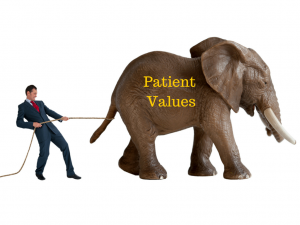Yesterday, the American Dental Association and the American Academy of Orthopedic Surgeons released new, evidence based guidelines regarding antibiotic prophylaxis before dental treatment in patients with joint replacements. The press release states that there is no evidence that dental procedures cause joint infections. Prior to this statement, we were to assume that a dental cleaning or placement of a filling had a special and dangerous power to seed the blood with frightening bacteria that somehow knew to go directly to the joint spaces of innocent artificial knees or hips with the malicious intent to infect.
For years I’ve been complaining to anyone who would listen about the joint replacement conundrum. Even though there was no evidence that premedicating patients was doing anyone any good, we did it. Because giving a patient a giant dose of antibiotics before having dental treatment is a much better option than having to treat or replace an infected joint, right? So just shut up and give them the antibiotics, Doc.
And that’s what we do. Each time I consult with a patient’s surgeon I get similarly frustrated. Some surgeons want premedication for the the rest of the patient’s life. Some surgeons want 6 months. Some want 2 years. Some think Amoxicillin is the way to go. Some say it’s Keflex or nothing. The one thing that all surgeons agree on is that they aren’t going to write the prescription for the antibiotics. That’s the job of the dentist. Which also means it’s the liability of the dentist. Let’s face it. Some patients can develop hypersensitivity to antibiotics and a huge dose of antibiotics could cause a reaction. Even a potentially severe reaction. And no one wants to be the one who wrote that script, right?
Let’s just get this out of the way. Most dentists don’t believe we’re doing a valuable service by premedicating our patients. Most of us know that eating a Dorito is at least as great of a risk as a dental cleaning for seeding the blood with oral bacteria. But we’re not rushing to premedicate patients prior to Dorito consumption. We’re doing it to cover our asses! We’ve been trained to cover our asses about this stuff since dental school. It has nothing to do with excellent patient care and everything to do with making sure we did everything right so that if some future joint infection or infective endocarditis event comes along we can prove that “it wasn’t us.” If it was really about excellent patient care, we’d have the ADA lobbying Frito Lay to bring out “Blazin’ Amoxicillin” Doritos.
I’m a dentist. My strength is treating dental disease. I’m a pretty smart guy, but frankly I’m not really up on the real risks of artificial joint infection or antibiotic allergies. How can I be expected to weigh the likelihood of two incredibly rare but very serious outcomes (joint infection vs. antibiotic reaction)? I don’t think it’s legitimate for the dentist to have their own policy. How about if the professional group that represents me, the American Dental Association, gives me some solid guidance so I don’t have to worry that I’ll be 1) harming my patients by not correctly weighing the risk factors and 2) you know…the lawyers.
But now, the evidence (or lack thereof) is in! We can stop worrying about the premedication for people with joint replacements because there’s no evidence of harm, right?
Ummm. No.
What the joint ADA-AAOS actually gives us are 3 “guideline recommendations.”
But recommendations are good, right? After all, the American Heart Association passed down (many times!) their recommendations on stone tablets for all dentists to know and heed! And by following recommendations it means that the lawyers can’t get us! I mean, as long as we follow the recommendations!
You’d think so. I mean, you’d think that having recommendations from the two big professional groups representing dentists and orthopedic surgeons would give us actual guidance on this issue. But it’s just not true.
The ADA-AAOS statement made me skeptical almost as soon as I started reading.
This summary of recommendations is not intended to stand alone. Treatment decisions should be made in light of all circumstances presented by the patient. Treatments and procedures applicable to the individual patient rely on mutual communication between patient, physician, dentist and other healthcare practitioners.
I read that and think, “these guidelines are perfectly fine, except you still have to evaluate patients on a case by case basis and if you get sued, we don’t have your back.”
I have to admit that I haven’t taken the time to read the full guideline, so my comments are based on the summary. The full guideline is somewhere around 100 pages and my own inability to concentrate for that length of time (thanks, internet!) has kept me from reading it. If someone does read it and find that I’m completely wrong, please let me know. I’d love to be wrong about this.
The recommendations strike me as incredibly watered down. They seem to be written as obliquely and indirectly as possible. Then each of them is given a “strength of recommendation” rating which means nothing to me. And they know this. So they give a definition about the strength of rating. Right after they give the strength of the rating. Honestly, it’s kind of bizarre.
The first recommendation addresses the use of prophylactic antibiotics:
The practitioner might consider discontinuing the practice of routinely prescribing prophylactic antibiotics for patients with hip and knee prosthetic joint implants undergoing dental procedures.
I might consider discontinuing antibiotics. Sure. I might. I might consider explaining my position to the patient, too. I mean they are the ones that are taking the very slight (but real!) risk here. But did I really need a recommendation from the ADA and the AAOS to tell me that I might think about it?
Further bolstering my opinion of this recommendation is the “strength of recommendation” score it’s given: “limited.”
A Limited recommendation means the quality of the supporting evidence that exists is unconvincing, or that well-conducted studies show little clear advantage to one approach versus another.
Practitioners should be cautious in deciding whether to follow a recommendation classified as Limited, and should exercise judgment and be alert to emerging publications that report evidence. Patient preference should have a substantial influencing role.
Recommendation 2 speaks to the use of preoperative topical oral antimicrobials:
We are unable to recommend for or against the use of topical oral antimicrobials in patients with prosthetic joint implants or other orthopaedic implants undergoing dental procedures.
So, they won’t say whether use of chlorhexidine prior to your filling is worth it or not. Great. Thanks for that. This strikes me as unnecessary because the risk profile of a swish of Peridex is a lot less than a megadose of Amoxicillin. In any case, they want us to know that we should feel “little contraint” in deciding whether to follow this recommendation. Gee, thanks.
Finally, the most bizarre recommendation.
In the absence of reliable evidence linking poor oral health to prosthetic joint infection, it is the opinion of the work group that patients with prosthetic joint implants or other orthopaedic implants maintain appropriate oral hygiene.
Really? Was there a time when I was supposed to be telling joint replacement patients that the risk of joint infection was so great that the shouldn’t floss? Or am I to assume that the ADA and AAOS feel that maintaining oral hygiene is vital to the health of an artificial joint? Honestly, I don’t even know what they’re trying to say. But at least they all agree on it. They give this recommendation a strength of: “consensus.”
A Consensus recommendation means that expert opinion supports the guideline recommendation even though there is no available empirical evidence that meets the inclusion criteria.
I had high hopes that the ADA would come through for us on this issue. I was hoping for an “AHA-like” guideline that would take the guessing out of this very common event for dental patients and dentists alike. It didn’t happen.
The most hopeful statement I got from the new guidelines is this:
Patient preference should have a substantial influencing role.
Although this statement was made specifically in reference to recommendation 2, I think it’s worth contemplating for the whole thing. Taking a large dose of antibiotics prior to dental appointments is not a risk-free event. I honestly don’t know if the data exists to weight the risk of taking antibiotics against the risk of joint infection at the dental office. I think patients can and should be part of the decision here.
The whole inconclusive data issue cuts both ways. Sure, there is no data to conclude that dental treatment causes joint infections. However, outside interests can just as easily claim that there isn’t data that dental treatment doesn’t cause infection in artificial joints. As a profession, we’re in the exact same spot that we were before these so called recommendations came out. We’re still going to cover our asses for the wrong reasons. It wasn’t good medicine before and it still isn’t.
What do I think should happen? I think the ADA and AAOS should sound off like they’ve got a pair. I think they should put a statement out that they’re going to help fund research on this topic to really answer the question and in the mean time they need to make a statement to dentists that “this is the recommendation and we’ve got your back if there’s a problem.” I think that the ADA should set aside a fund for the inevitable legal challenges that will come along to such a definitive statement and let member dentist’s know that they will be represented. It’s time to do the right thing for the right reason.
Am I right on the money? Am I completely dead wrong? I’d like to hear what you think. Feel free to leave a comment here or email me at alan@meadfamilydental.com.
 I’m positive that my friend had the patient’s best interests at heart. He knows how to deliver some amazing care. I think he persuaded her why she should value the kind of care he wanted to deliver to her without her actually valuing the care.
I’m positive that my friend had the patient’s best interests at heart. He knows how to deliver some amazing care. I think he persuaded her why she should value the kind of care he wanted to deliver to her without her actually valuing the care.
